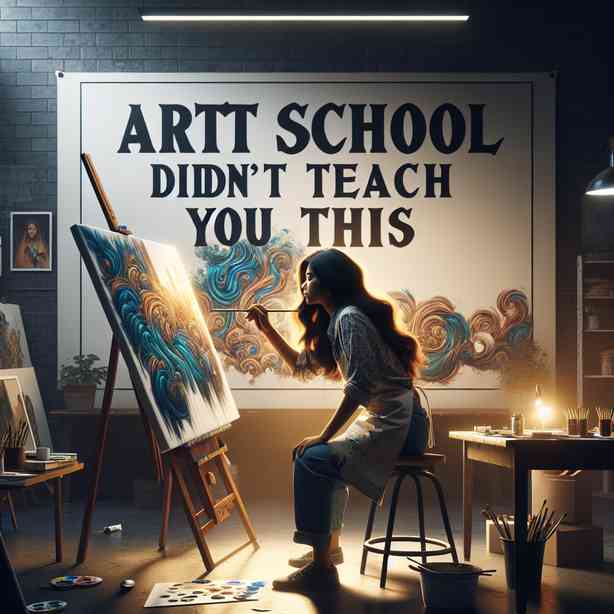
In the ever-evolving world of art, education is a vital component that shapes the creativity and skills of aspiring artists. Many individuals who attend art schools often find themselves equipped with foundational techniques, theories, and historical contexts. However, as they transition into their professional careers, they soon discover that there are significant lessons not covered in their curriculum. This article seeks to illuminate some of the critical aspects of the art world that art schools may not fully address but are essential for thriving in this competitive landscape.
One of the first lessons that many artists learn is the importance of self-promotion and personal branding. While art schools may touch on the significance of creating a portfolio, they often do not delve deep into the strategies needed to effectively market oneself in a digital age. In today’s world, an artist’s online presence can greatly influence their career. Building a personal website, utilizing social media effectively, and engaging with audiences are critical skills that many artists must cultivate independently. Artists need to learn how to narrate their artistic journeys and present their work in ways that resonate with potential buyers, galleries, and collectors.
Another aspect that often goes underexplored in academic settings is the business side of art. Understanding the economics of art sales, pricing artwork appropriately, and managing finances are crucial skills for any artist looking to make a living from their craft. Many graduates find themselves ill-prepared for the financial realities of being an artist. It is essential to understand how to negotiate contracts, interact with galleries, and handle commissions. Additionally, understanding the value of an artist’s work and what drives market demand can empower artists to take charge of their careers and make informed decisions about their artistic output.
Networking is another critical component of an art career that art schools may not prioritize. While students may have opportunities to connect with peers and faculty, they might not receive adequate training on how to build professional relationships within the art community. Attending exhibitions, art fairs, and artist talks can be immensely beneficial for budding artists. It is through these interactions that they can learn, grow, and find mentors who can provide support and guidance. Establishing a diverse network of contacts can lead to collaboration opportunities, studio visits, and even job offers.
Moreover, navigating the emotional landscape of being an artist is a nuanced topic that art institutions may overlook. The art world is fraught with critiques, rejection, and competition, which can take a toll on an artist’s mental health. Learning to manage these emotional challenges, developing resilience, and maintaining a positive creative mindset are crucial for longevity in this field. Artists must discover ways to cultivate their creativity without falling prey to self-doubt and burnout. Engaging in self-care practices, seeking community support, and being open about their struggles can help artists navigate their emotional journeys more effectively.
In addition, artists often find themselves needing to adapt to various styles and mediums that may not have been part of their formal education. The ability to experiment and diversify one’s skills is essential in a market that is constantly seeking fresh ideas and innovation. Many successful artists continuously explore new materials, techniques, and concepts, pushing the boundaries of their work. This willingness to innovate and adapt can set an artist apart from their peers and attract a wider audience. Embracing a multidisciplinary approach can enrich an artist’s practice and lead to exciting new directions in their work.
Another critical area is understanding the role technology plays in contemporary art. With advancements in digital art, augmented reality, and artificial intelligence, the landscape of what constitutes art has broadened immensely. Artists must be willing to embrace new technologies and understand how they can enhance or transform their artistic expression. Familiarity with tools such as digital design programs, 3D modeling, and even video editing can provide artists with additional avenues to showcase their work. This technological fluency can open doors to collaborations and exhibitions in a variety of settings, offering new ways to engage audiences.
Furthermore, sustainability and ethical considerations in art practices are becoming increasingly relevant. Artists today are called to reflect on their environmental impact and the materials they utilize in their work. Understanding sustainable practices not only resonates with a conscientious audience but also aligns with a broader societal shift towards environmental awareness. By incorporating eco-friendly materials and considering the lifecycle of their artworks, artists can contribute positively to the planet while enriching their creative practices.
Finally, art is inherently tied to community engagement and social issues. Understanding the socio-political context of their work and how it relates to current events can help artists create meaningful dialogue through their art. Whether addressing social justice, mental health, or cultural identity, artists have a unique perspective that allows them to influence and inspire change. Engaging with communities, attending workshops, and participating in outreach can enhance their understanding of the world and provide depth to their artistic expression.
In conclusion, while art school provides a strong foundation for aspiring artists, several crucial lessons exist outside the classroom that can significantly impact their careers. From mastering self-promotion and developing business acumen to navigating emotional challenges and embracing technological advancements, artists must remain proactive in their learning. The art world is dynamic and multifaceted, and those who thrive are often those who continuously seek growth, adaptation, and connection. By understanding these additional dimensions of their practice, artists can cultivate fulfilling and sustainable careers in art. The journey may be fraught with challenges, but every experience contributes to their growth as artists and individuals. Embracing these lessons will lead to a more enriched and impactful artistic path.


